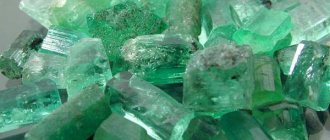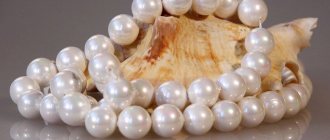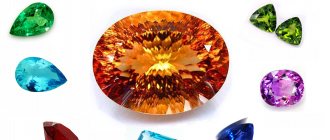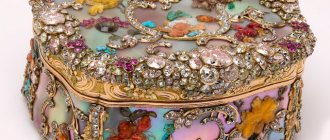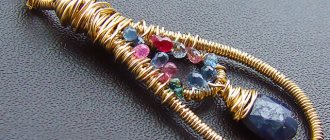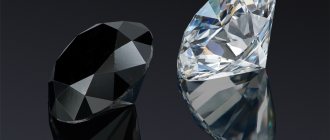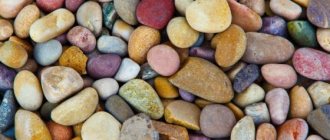Precious minerals
There are quite a lot of stones representing the whole gamut of green in nature. Among them are the well-known emerald and jade, as well as the less famous peridot, tsavorite and verdelite. For a number of minerals, green is the main color, while for others it is a rare and valuable variety.
MERCURY – EMERALDEmerald, the main gemstone of Mercury, maintains a balanced ratio of all three...
Published by Astrology, Ayurveda Wednesday, April 1, 2015
Emerald
The most famous gemstone is green. By its nature, it is a type of beryl group. The rich color of fresh greens ensures a high content of chromium impurities in the mineral.
Emerald is a durable stone that can be cut in almost any way. High quality minerals are transparent and uniform in color. Most of them are mined in Brazil, Egypt, and Zambia. This gem is also mined in Colombia, the USA, Russia, India, South Africa, India, Pakistan and China.
Interesting! The largest emerald in the world, Theodora, weighs 11.5 kg (57,500 carats).
Alexandrite
A rare and amazing mineral, one of the five most expensive gems in the world. Its distinctive feature is its color reverse. When changing lighting from natural to artificial, the gem changes shade from green to red. Jewelry made from this stone is mainly made to order.
Alexandrite is of Russian origin, as it was first found in the mines of the Urals. Today this mineral is also mined in Sri Lanka, Brazil, Tanzania and Madagascar.
Sapphire
The green variety of sapphire is called chlorosapphire or oriental emerald. Alexander the Great wore a ring with this stone, considering it his talisman and amulet.
High-quality sapphires are cut into oval or circle shapes. A stepwise cutting method is often used, which increases the refractive index of light. Lower quality gemstones are cut into cabochons.
Deposits of green sapphires are located in Myanmar, India, Australia, Thailand, Madagascar and the USA.
Interesting! It is not impurities and inclusions that are responsible for the green tint of a crystal, but a structure consisting of alternating yellow and blue layers.
Diamond
One of the rarest minerals is green diamond. This fancy gemstone owes its color to inclusions of nitrogen and irradiation with uranium and thorium during its crystallization process.
In laboratories, they have learned to “color” transparent stones using irradiation, but such specimens are significantly inferior in price to the originals.
Deposits of valuable gems have been discovered in South Africa, Australia, India, Brazil and Russia (Siberia).
| Name | Origin | Characteristics | Price per 1 carat (in rubles) | ||
| Color | Substance that affects color | Hardness | |||
| Emerald | one type of beryl | yellow-green to blue-green | chromium impurities | 8 | from 90-100 thousand |
| Alexandrite | type of chrysoberyl | color reverse | chromium impurities | 8,5 | from 300 thousand |
| Sapphire | type of corundum | light to dark green | No | 9 | from 35 thousand |
| Diamond | type of graphite | yellow-green to dark | nitrogen impurities | 10 | from 1 million |
The best settings for precious gems are yellow gold and platinum. Jewelry with these stones will not only be a luxurious gift, but also a good financial investment.
Green Gems for Collectibles
Some gems are good for display. At the same time, they are protected from impacts and scratches that may occur when used in jewelry. The following green gemstones may not be suitable for jewelry, but will add color and interest to your collection.
Chrome sphene
Emerald-colored chrome sphene, with more fire or dispersion than diamond, is a rare gemstone. Although this stone is soft and fragile, it is sometimes used in jewelry. This variety of sphene is the rarest and most valuable, and stones of good clarity above one carat are collector's items.
This beautifully cut chrome sphene exhibits beautiful brilliance and dispersion. © JL White Fine Gemstones
Ekanite
If you like the feeling of danger, consider adding ekanite to your collection. While its muted olive green color doesn't scream "Danger!", this mineral contains uranium and thorium, making it quite radioactive. Small ekanites do not pose a serious health risk, but even a 5-carat stone will more than quadruple your average annual radiation dose.
Weighing 9.74 carats, this ekanite is quite radioactive, so you shouldn’t touch it often. © The Gem Trader
Giddenite
Giddenite is one of the most difficult gemstones to cut. When you try to process it, it may simply fall apart. Hiddenite is the green variety of the mineral spodumene, which you may be better known by its pink variety, kunzite. Since spodumene has two cleavage planes, it can break with little force.
A seafoam green Giddenite ring should be worn with great care. © The Three Graces
It's probably best left hidden in a display case, but you can discreetly wear it around your neck as a pendant. Wear this gemstone only with evening wear because its colors will fade with prolonged exposure to the sun and even just bright light.
Gaspeite
Light green gaspeite is a popular nickel mineral among collectors. It should be handled with care, because nickel is a carcinogen and can cause skin irritation. Because this mineral is soluble in some acids, skin contact and accidental ingestion may result in a toxic reaction. Wearing gloves when working with gaspeite and using a respirator to prevent inhalation of particles while cutting these stones will help you avoid any adverse effects.
A bright green large gaspeite pendant will attract attention everywhere. © Sewell's Indian Arts
Seraphinite (clinochlore)
Seraphinite cabochons (the trade name for green clinochlore) have found their way into jewelry. However, this stone is best left at home for display purposes only. It is so soft that you can even scratch it with your fingernail. This means that a polished cabochon will tarnish over time. However, seraphinite can be a visually attractive stone in the low price range.
White swirls on green give seraphinite a whimsical appearance. © Mineral Miners
Source of information material and illustrations https://www.gemsociety.org/article/green-gemstones/
Semiprecious stones
Translucent greenish minerals with a wider geographical distribution are classified as semi-precious stones. They are no less beautiful than representatives of the first group, but at the same time they are cheaper.
Chrysoberyl
It belongs to the beryl group, just like emerald. When processed, it acquires transparency and high-quality glass luster. The most valuable stones are minerals with a “cat’s eye” effect.
They are mined in Brazil, Madagascar, the USA, Canada and Sri Lanka. In Russia, mining is carried out on the Kola Peninsula.
Chrysolite
A variety of olivine (green garnet) is yellowish-green in color with a golden tint. For a long time, peridot was confused with emeralds of medium quality, until differences in the chemical composition were discovered. The green tint is caused by the presence of iron inclusions.
The mineral is mined in Russia (Yakutia), South Africa, Egypt and Tanzania.
Interesting! Geologists call this stone “the natural satellite of diamond.” Mineral deposits are in most cases nearby.
Beryl
Transparent crystals of light green or bottle shade are often used by jewelers to produce expensive jewelry. Beryl gets its color due to impurities of II-valent iron.
The green mineral is mined in India, Brazil and France. In Russia, deposits have been discovered in the Ilmen Mountains and on the Kola Peninsula.
Must see: Chameleon stones: jewels that change color
Demantoid
A rare and most valuable variety of garnet with a characteristic brilliant shine. The rare shade is the result of inclusions of chromium and iron in the structure of the stone. Demantoid is the most expensive of the garnets.
The best examples of this gem are mined in Russia, in the Urals.
Interesting! The high refractive index and unique color became the basis for recommending the inclusion of demantoid in the class of precious stones.
Tsavorite
Also one of the rarest types of garnet, mined in Tanzania on the Tsavo River. The bright green color is very reminiscent of the color of natural emerald. The unusual shade is provided by impurities of vanadium and chromium. It is distinguished by its small size (up to 5 carats).
Uvarovite
Another representative of the pomegranate group, named after Count Uvarov S.S. The second name of the stone is “Ural emerald”. It is mined mainly in the Urals, Finland, Norway, Canada, Turkey and the USA.
The mineral is distinguished by a greenish tint with a strong shine and small size (about 1 mm). The composition contains chromium. A special feature of use is the lack of cutting. The stone is used in its natural form.
THE MAGICAL POWER OF EMERALDOnly this stone was considered worthy of Cleopatra’s beauty and spent her evenings looking at...
Published by The Empire of the Strongest Witches by Alena Wormwood Friday, August 11, 2022
Verdelite
The tourmaline variety pleases the eye with olive tones, sometimes turning into khaki tones. The step cut brings out the color, while the diamond cut accentuates the sparkle. Often combined with other types of tourmaline in intricate brooches, rings and necklaces.
The mineral is mined in Asia, Pakistan, the Kola Peninsula and the Urals, as well as in Namibia and Madagascar.
Moldavite
The second name of the mineral is “bottle stone”. Discovered in the Czech Republic, near the Moldau River. The main deposit is located there in a crater formed after a meteorite fell.
Jewelers use both cut and natural samples. Raw moldavite looks impressive in the form of pendants and pendants.
Chrome diopside
This stone is called the “Yakut emerald” because of the large deposits discovered in Yakutia. In addition to Russia, production is carried out in Brazil, Tanzania, Finland, South Africa and Madagascar.
Opaque stones are used as an ornamental material, while transparent ones go to jewelers. The emerald color is the result of chromium impurities.
Agate
The bright green mineral is rare in nature, so it is especially valued by collectors and craftsmen. The dark emerald hue is achieved by exposing chromium salts to high temperatures.
The main suppliers of green agate are Mongolia, Brazil, Russia, Uruguay and Africa. The optimal cut shape that reveals the beauty of the stone is a cabochon.
Prasiolite (green amethyst)
A mineral with a fairly wide palette from onion green to rich emerald tones. The latter are extremely rare in nature and most often are the result of heat treatment of stone in a laboratory.
Gems are mined in Canada, Namibia, Tanzania, Brazil and Poland.
Prosopal
This rare variety of opal is distinguished by its rich, young green color and high water content. The transparency of the stone also depends on the last factor. At a content of 30%, the mineral becomes transparent; when reduced, the gem “turns” into chalcedony.
The saturation of the shade is regulated by the percentage of silica.
Mined in Tanzania, Peru and Australia.
All the main characteristics of semi-precious minerals can be presented in the form of a table:
| Name | Origin | Characteristics | ||
| Color | Hardness | Price for 1 carat (in rubles) | ||
| Chrysoberyl | one type of beryl | from green-yellow to green-blue | 8,5 | from 1.5 thousand |
| Chrysolite | type of pomegranate | yellow-green | 6,5-7 | from 3 thousand |
| Beryl | ring silicate | green, bottled | 7,5-8 | from 2 thousand |
| Demantoid | type of pomegranate | emerald with high shine | 6,5-7 | from 12 thousand |
| Tsavorite | type of grossular | deep green | 7-7,5 | from 10 thousand |
| Uvarovite | type of pomegranate | emerald green | 6,5-7 | Silver ring from 10 thousand |
| Verdelite | variety of tourmaline | olive, gray-green | 7,5 | from 10 thousand |
| Moldavite | siliceous rock | muted green | 6 | from 5 thousand |
| Chrome diopside | type of diopside | emerald | 5,5-6 | from 2 thousand |
| Agate | type of quartz | dark green | 6,5-7 | from 1000/g |
| Prasiolite | type of quartz | onion green | 7 | from 1.5 thousand |
| Prosopal | type of quartz | light to bright green | 6-6,5 | from 600 |
Semi-precious minerals are often used in the manufacture of luxury jewelry, as a frame for more valuable stones, and as a material for making crafts.
Be sure to check out: What blue gemstones are called and look like
Stones are most often set in jewelry alloy or silver.
Do green stones evoke a sense of harmony in you?
Not really
Green gemstones to wear on occasion
Unfortunately, not all green gemstones are durable. Some are soft or prone to chipping or cracking. These gemstones are best suited for earrings, pendants and brooches. If you are creating a ring with one of the green gemstones described below, use a setting with a stone protector to minimize chips and scratches.
Emerald
Of all the green gemstones on our planet, emerald is perhaps the most popular. It has given rise to many legends and has been used in famous jewelry. A May stone with a hardness of 7.5 to 8, it will most likely not be scratched. However, it may come as a surprise to some that an emerald is not as good an option for a ring as a ruby or sapphire. Emeralds always have defects in their crystal structure that can cause them to break if accidentally hit. These gemstones are often treated with oil to enhance their appearance.
An emerald cut emerald flanked by trillion cut diamonds is a classic look for an engagement ring. © CustomMade
Peridot
Have you ever seen gems falling from the sky? This happens with peridot, the birthstone of August. It is formed in volcanoes. During eruptions, some volcanoes release peridots into the sky, and they fall to the ground nearby. Some peridots even come from outer space, recovered from pallasite meteorites.
While many peridots are yellow-green in color, this hexagonal Arizona peridot is closer to pure green. © JL White Fine Gemstones
While these yellow-green stones are popular and affordable, they are not the most durable. Peridots can break and are sensitive to acids and sudden changes in temperature.
Chrome diopside
One of the most popular green gemstones for jewelry is chrome diopside. Much of this material comes from a deposit in Eastern Siberia discovered in 1988. More recently, Pakistan has produced some chromium diopside.
Despite the relative rarity of this stone, prices remain low. It is dark green in color, making it a natural choice for inexpensive jewelry. But you need to keep in mind: chrome diopside is a soft stone and is prone to scratches. It can also shatter if hit, so it is not suitable for constant wear.
Chrome diopside is an excellent choice for creating vibrant colors in jewelry. Photo liveauctioneers.com and Leonard Auction, Inc
Moldavite
If you're into all things alien or just love olive green, check out moldavite jewelry. This green gemstone is actually a type of natural glass that is formed when meteorites fall. When a meteorite hits the earth's surface, some of the surrounding rock becomes liquid and is released into the atmosphere. (Similar to how a stone hits water, only instead of water there is liquid stone!) As it cools, this rock forms glass.
Like any glass, the mineral is easy to scratch, so be careful when storing moldavite jewelry.
The weight of this moldavite is 4.8 carats. This is the right size for a necklace. © RSA Gems
Turquoise
Did you know that turquoise can be green? Although most turquoise has a signature blue-green hue, in some regions there is much more green in turquoise. Turquoise from Lake Carico, Nevada is often a vibrant apple green with intricate black web patterns. Stones from other sources may have a bluish-green tint.
Turquoise in green shades is less common than minerals in blue shades. © Market Square Jewelers
Sunstone and Oregon Sunstone
Feldspar is one of the most common minerals in the earth's crust. However, these varieties of feldspar have become favorites among collectors. Sunstone contains small inclusions of iron, and Oregon Sunstone contains inclusions of copper, which create a sparkling effect. Although red minerals are the most popular, stones with green to blue-green hues are also a great option.
The rare blue-green color of this Oregon Sunstone is one of the most sought after by collectors. © Ravenstein Gem Co
Zoisite
Zoisite is best known for its violet-blue variety, tanzanite, but it comes in other colors. Because of this, green zoisite is sometimes called "green tanzanite", although this name is a misnomer. Green zoisite is rarely transparent, making the cut gemstones highly collectible. However, ruby in zoisite, a stone composed of opaque green zoisite, black hornblende and opaque red ruby, can produce wonderful decorative features.
Sparkling green zoisite is an unusual stone that is sure to attract attention. © Mineral Miners
Malachite
This copper mineral has green stripes that give it a natural beauty. Malachite was also symbolically associated with money. Sometimes malachite, growing to large sizes, becomes an interesting material not only for jewelry, but also for decorative items. However, it is soft, fragile and sensitive to heat and acids.
The striped green malachite in this bracelet is beautifully complemented by rhodolites. © Carolyn Pollack Jewelry
Green zircon
Although this mineral is often confused with cubic zircon, a known diamond imitator, zircon is a fantastic natural gemstone and one of the birthstones for December. While white zircons can imitate diamonds and blue zircons are inexpensive, everyone's favorites, green zircons are rare, collectible gemstones. They are rarely bright green. Olive-colored minerals are more common.
Zircon is hard enough to resist scratches, but its edges chip easily. Wearing earrings or necklaces occasionally will help keep the damage to a minimum.
Zircon is known for its impressive brilliance. It turns out that even dark green gemstones can sparkle. © Market Square Jewelers
Serpentinite
The official state stone of California and a favorite counterpart to jade, serpentinite is an excellent stone for cutting or cabochoning. Despite its softness, this metamorphic rock is often found in inexpensive jewelry. Serpentinite in olive green shades is an interesting decorative stone.
This 32-carat serpentinite has a translucency reminiscent of jade. Photo by liveauctioneers.com and Jewelry Liquidation.
Prehnite
Rarely found transparent apple green prehnite makes interesting cabochons. In some cuts, translucent stones have a soft, velvety appearance. With a hardness rating of 6 to 6.5 on the Mohs scale, this gemstone is fairly scratch resistant, but breaking can make it difficult to cut.
Soft and translucent, faceted prehnite is a rare gemstone. © Coast-to-Coast Rare Stones International
Green apatite
Apatite is actually a group of minerals that includes many types of gemstones, but the term is often applied to simply any member of this family.
Although blue-green is the most common color, green apatites, or “asparagus stones,” are also found. However, be careful with apatite jewelry. Use this soft and fragile stone for pendants and earrings.
This apatite specimen has an unusual, attractive green-blue color. © The Gem Trader
Variscite
Variscite is a popular material for making cabochons and cutting. It has lovely light green shades. This stone is too soft to be worn regularly in a ring, but it can be used to make attractive beads. People have valued variscite beads for thousands of years. French archaeologists have discovered beads from this Neolithic stone that are over 6,000 years old.
The soft green-blue hue of this variscite is reminiscent of the sea. © Carolyn Pollack Jewelry
Cornerupin
This rare gemstone is most prized for its green color, which can resemble emerald. Cornerupine is rarely found as a cut gemstone and tends to be small in size, with prices rising rapidly. Although its hardness ranges from 6 to 7, cornerupine has a perfect cleavage in two directions, so if hit poorly, it can simply crack.
Mint green cornerupine is not as rich as some gemstones, but it is bright and shiny. © Earth's Treasury
Ornamental green stones
This group is considered the most widespread on the planet in terms of the number of representatives. Stones of this class are used to make both jewelry and interior and household items.
Nephritis
A valuable mineral with a history of several thousand years. Belongs to the group of jads. It was from green jade that the imperial seals of China were most often made, so this mineral has special significance for the inhabitants of the Middle Kingdom.
Color variations range from onion green to emerald gray. Dark and white veins, dots, and small spots can be visible in the structure.
The main deposits are located in China, Canada, the USA, Kazakhstan and Russia (Tuva).
Interesting! In China, mini-figurines made of jade are very popular, representing any wish. For example, peach means longevity, and fish means wealth.
Chrysoprase
One type of chalcedony has a wide palette of shades: from light apple to green-blue. The stone is characterized by its rich color and is often used by jewelers in combination with silver or gold settings.
The light green tint results from the inclusion of nickel in the structure. The stone is mined in Australia, Brazil and Germany.
Amazonite
A mineral that has long been confused with jade. This is actually a cheaper type of feldspar. Often used in inlays, in the manufacture of interior items and jewelry.
The main deposits are located in the USA and Russia (Ilmen Mountains).
Onyx
This green stone is often used to make countertops, dishes, interior items and spectacular gift souvenirs. It is often confused with agate, however, the color of onyx is lighter and more diffuse. If there are brown inclusions, the mineral becomes like marble.
Mined in South America, Uruguay, Egypt, USA, Asia and Pakistan.
Aventurine
This type of quartz is presented in a gray-green shade. Opaque specimens are often set in silver and used to make inexpensive jewelry, dishes, vases and boxes.
The largest deposit is in India.
Important! Aventurine is the most often counterfeited. Cloudy glass or plastic is used as an imitation.
Properties and uses of green stones
Crystals of greenish shades are used in a variety of fields. Precious and semi-precious rocks are used to make exquisite jewelry, inlaid with attributes of power and expensive interior items.
Ornamental stones are used to make jewelry and silver jewelry. They are sold at crafts fairs or in handicraft departments in cut and natural forms.
Ornamental gems are used for interior and exterior decoration of buildings. Used for decorating furniture (cabinets, tables), creating interior items (figurines, caskets). Even countertops are made from some minerals.
Dishes made from natural stones look original. Lithotherapists believe that eating food from such devices is beneficial.
Low grade varieties of gems are used in industry. Suitable for paving roads, making natural dyes, creating pyrotechnics.
Medicinal properties
Lithotherapists believe that green stones:
- relieve chronic fatigue and overstrain;
- tone, energize;
- normalize metabolism;
- improve oxygen saturation of tissues;
- activate the immune system;
- improve vision;
- relieve stress;
- help cure respiratory diseases;
- relieve headaches.
Magic properties
Psychics say that green minerals have powerful energy. Magic properties:
- Protect from the evil eye, damage, envy, black magic. It is useful to hang gems near the baby's crib.
- They help you find love and save your family. They make the owner attractive to others.
- Develop hidden abilities and intuition. If a person has magical abilities, then the talisman will help reveal them.
- They attract good luck in business, provide an opportunity to climb the corporate ladder and get rich.
- They attract good luck in all endeavors. The owner of the stone will have every chance to achieve his goals.
- Gives the owner self-confidence and energy. People associated with magic will also be able to draw on the energy of the talisman.
Each type of mineral has its own horoscope compatibility. Therefore, when choosing a talisman, you need to take into account not only the shade, but also what element it belongs to.
Sometimes green stones appear in dreams. They talk about quick wealth, fame, success. If the gem is lost, then this means serious trouble.
Green ornamental species
A number of ornamental breeds are characterized by the presence of green as the main tone of the color palette.
Jade
Another mineral that is often confused with jade. However, jadeite is much less common and highly valued. The main palette includes shades from bright green to dull bottle green. The most expensive specimens with a high degree of transparency and rich color are called “imperial”.
It is mined in Japan, China, Mexico, USA, Kazakhstan and Russia (Khakassia).
Malachite
The famous Ural mineral, glorified in Bazhov’s tales, has a rich turquoise color with dark veins and inclusions. One of the features is a silky soft shine.
Malachite is an ornamental stone. Mini-figurines, dishes, vases, interior items and even furniture are made from it. It is often used for inlays and finishing.
Interesting! In the Hermitage, a whole room is dedicated to products made from this stone, which is called “malachite”.
Coil
The stone got its name because of its original coloring, reminiscent of a snake skin. The main shade is swamp green with dark splashes and veins. Everything is made from coils: from jewelry to facing tiles.
The largest deposits of stone were found in the USA, Great Britain, Germany and Russia (Urals, Caucasus, Tuva).
Seraphinite
The second name of the mineral is clinochlore. The stone has an unusual color. On a dark green background there are radiant pearlescent inclusions that seem to spread over the surface of the mineral.
Clinochlore is cut into cabochons and used to make rings, pendants and earrings. Seraphinite deposits are present in countries such as Japan, Korea, Greece, Pakistan and the USA.
Properties of green stones
Since ancient times, green stones have been considered healing. This color represented living nature - grass, foliage, plants.
It was believed that contemplation of green crystals could restore vision and alleviate eye diseases, and the use of individual minerals could help with a number of more serious ailments.
Thus, lithotherapists recommend wearing moldavite bracelets for people suffering from fluctuations in blood pressure, and rings with emerald for those who suffer from depression or are in a state of constant stress.
Beryl can speed up metabolism, malachite will help with asthma, a jade massager is recommended for lower back or joint pain, and green garnet will restore male strength.
It is believed that opaque minerals of a rich green color have the most powerful healing effects.
Esotericists also recommend having one or more jewelry with green precious inserts in your arsenal. Thus, gold earrings with emeralds can dispel negative energy directed at their owner, and a rare green diamond will become an invaluable amulet for the expectant mother and baby.
Beryl talismans can protect against the evil eye, chrysoberyl will attract good luck, chrysolite will increase self-confidence, and sapphire will attract financial well-being.
Green stones in jewelry
Deeply colored stones are especially valued by jewelers. They usually have an open frame to highlight the beauty of the shade.
Gemstones are usually combined with white gold or platinum. These metals accentuate the unusual color. Yellow gold and silver are combined with semi-precious minerals. Cupronickel and titanium are sometimes used.
Costume jewelry is made from semi-precious stones. Often they are not framed with metal, but are decorated in the form of beads and bead bracelets.
It is important to store jewelry correctly. For products with natural gems, general care rules:
- Jewelry is stored in separate cases in a common box or placed in a velvet-lined box.
- It is undesirable to expose stones to sunlight, moisture, or chemicals.
- To clean the mineral, wash it with warm water and baby soap. Then wipe and polish with a soft cloth.
See a review of jewelry with some green gems:
Main conclusions
Green gems are extremely popular due to the positive energy of this natural shade.
- Most green gemstones are rare varieties of the base mineral and therefore cost more (garnet is an exception).
- Semi-precious stones are used not only in the jewelry industry, but also in the production of interior items and premium items (bags, accessories).
- Precious stones are framed in gold and platinum, less valuable in silver and jewelry alloy.
- Ornamental species are often used as material for inlays.
- Ornamental species can be used in the manufacture of furniture.
The scope of application of green stones is unusually wide. The same mineral can be used to make exquisite jewelry and to surround a fireplace. The popularity of gems is due not only to the main tone, but also to the rich color palette with a variety of inclusions, which only emphasize the beauty and uniqueness of the material created by nature.
Share your impressions of what you read and leave feedback in the comments.

